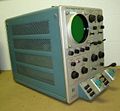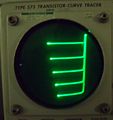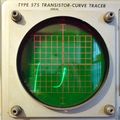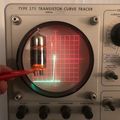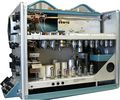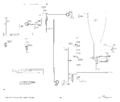575: Difference between revisions
No edit summary |
No edit summary |
||
| Line 53: | Line 53: | ||
=== Power Supplies === | === Power Supplies === | ||
The 575 contains three separate power supplies: | The 575 contains three separate power supplies: | ||
* | * A '''main power supply''' around T601 (120-095 and, later, [[120-0095-01]]), supplying power to the amplifiers and step generator in the 575. | ||
:This power supply follows the standard 500-series power supply design. | |||
This power supply follows the standard 500-series power supply design. | :In addition to heater power, it provides −150 V, +100 V, +300 V regulated and +400 V unregulated output. | ||
In addition to heater power, it provides | :It uses a mix of tubes and silicon or [[selenium rectifiers]] (earlier S/N) for rectification. | ||
It uses a mix of tubes and silicon or [[selenium rectifiers]] (earlier S/N) for rectification. | :The −150 V and +400 V unregulated/+300 V regulated rails are supplied through [[6BW4]] full wave rectifier tubes, the +100 V circuits through silicon diodes/[[selenium rectifiers]]. | ||
:The −150 V rail is the main reference supply. Its regulator uses a [[5651]] voltage reference, a [[6AN8]] as the comparator/error amplifier, and a [[12B4]] as series pass tube. | |||
:The +100 V regulator uses a [[6080]] series pass tube and a [[6AU6]] tube as the error amplifier. | |||
+ | :The +300 V regulator is similar to the +100 V circuit, except that it uses a [[12B4]] series pass tube. | ||
+ | :Unregulated +400 V is provided for the CRT HV Oscillator. | ||
+ | * A '''high-voltage supply''' around T801, supplying the CRT voltages, +2300 V for the CRT anode and −1700 V for the CRT cathode. | ||
:This HV power supply uses a [[6AQ5]] as the HV oscillator tube, and a [[12AU7]] as the feedback/error amplifier. | |||
* A '''collector sweep supply''' for to the device under test. | |||
* | : Power from the mains goes through an isolation transformer (T701) and a variac (T702) and is rectified by germanium diodes to produce the collector sweep voltage. | ||
This HV power supply [[6AQ5]] as the HV oscillator tube, and [[12AU7]] as feedback/error amplifier. | : The isolation transformer has two pairs of secondary taps, one for high voltage (0 to 200 V) and low current, the other for low voltage (0 to 20 V) and high current. | ||
: The maximum power that can be delivered to the transistor in either mode is approximately 200 Watts. | |||
* | : 575s with Mod 122C offer extended collector sweep voltage to 400 V. | ||
Power from the mains goes through an isolation transformer and a variac | |||
and is rectified by germanium diodes to produce the collector sweep voltage. | |||
The isolation transformer has two pairs of secondary taps, | |||
one for high voltage (0 to 200 V) and low current, the other for low voltage (0 to 20 V) and high current. | |||
The maximum power that can be delivered to the transistor in either mode is approximately 200 Watts. | |||
=== Rectifiers === | === Rectifiers === | ||
Revision as of 07:46, 5 October 2018
The Tektronix 575 is a curve tracer for transistors, introduced in March 1957. It can be thought of as being composed of three modules: an X-Y display, a step source, and a collector sweep source.
Key Specifications
| Collector Sweep | 0−200 V minimum peak with 1 A current curves, 0−20 V minimum peak with 20 A current curves |
|---|---|
| Vertical Display | plots collector current from 0.01 mA/div to 1 A/div ±3% in 16 Steps |
| Vertical Display | plots base voltage from 0.01 V/div to 0.5 V/div ±3% in 6 Steps |
| Horizontal Display | plots collector voltage from 0.01 V/div to 20 V/div ±3% in 11 Steps |
| Horizontal Display | plots base voltage from 0.01 V/div to 0.5 V/div ±3% in 6 Steps |
| CRT | T52P, P1 phosphor, P2/P7/P11 on request ; 4.2 kV acceleration |
| Line voltage | 105−125 V or 210−250 VAC, 50 to 60 Hz |
| Power | 200 W in standby, 400 W max − Actual consumption based on transistor being tested |
| Size | (W/L/H) 13" × 24" × 16¾" |
| Weight | ~30 kg (70 lb) |
| Cooling | AC Fan |
| Construction | Aluminum alloy chassis, anodized front panel, blue vinyl coated cabinet |
History
While I was working on the 540 series vertical amplifier, Virgil Briton, whose bench was next to me, had put together a vacuum tube curve tracer using stepping relays and other mechanical devices. I remember thinking that, that was a neat display even if it did a lot clicking and was slow. After putting the cross hatch generator together, I knew it would be very easy to do the curve tracer electronically,it started for in house use,but after putting a self-contained instrument together, Tek decided to call it 575 and sell it.
Internals
X-Y display
The vertical and horizontal amplifiers are very similar, using the two halves of a 6CG7 dual-triode tube as the output amplifier. The CRT has −1700 V on the cathode and +2500 V on the anode. The HV power supply uses two 5642 rectifier tubes.
It is possible to use the 575 as an X-Y monitor. The vertical and horizontal range switches have settings for external input, at 0.1 V/div sensitivity.
Step Source
This uses a gated Miller integrator to generate controlled steps. The result is a staircase waveform, which generates different traces in the the family of I-V curves of the transistor.
Power Supplies
The 575 contains three separate power supplies:
- A main power supply around T601 (120-095 and, later, 120-0095-01), supplying power to the amplifiers and step generator in the 575.
- This power supply follows the standard 500-series power supply design.
- In addition to heater power, it provides −150 V, +100 V, +300 V regulated and +400 V unregulated output.
- It uses a mix of tubes and silicon or selenium rectifiers (earlier S/N) for rectification.
- The −150 V and +400 V unregulated/+300 V regulated rails are supplied through 6BW4 full wave rectifier tubes, the +100 V circuits through silicon diodes/selenium rectifiers.
- The −150 V rail is the main reference supply. Its regulator uses a 5651 voltage reference, a 6AN8 as the comparator/error amplifier, and a 12B4 as series pass tube.
- The +100 V regulator uses a 6080 series pass tube and a 6AU6 tube as the error amplifier.
- The +300 V regulator is similar to the +100 V circuit, except that it uses a 12B4 series pass tube.
- Unregulated +400 V is provided for the CRT HV Oscillator.
- A high-voltage supply around T801, supplying the CRT voltages, +2300 V for the CRT anode and −1700 V for the CRT cathode.
- This HV power supply uses a 6AQ5 as the HV oscillator tube, and a 12AU7 as the feedback/error amplifier.
- A collector sweep supply for to the device under test.
- Power from the mains goes through an isolation transformer (T701) and a variac (T702) and is rectified by germanium diodes to produce the collector sweep voltage.
- The isolation transformer has two pairs of secondary taps, one for high voltage (0 to 200 V) and low current, the other for low voltage (0 to 20 V) and high current.
- The maximum power that can be delivered to the transistor in either mode is approximately 200 Watts.
- 575s with Mod 122C offer extended collector sweep voltage to 400 V.
Rectifiers
Early 575 versions used selenium rectifiers. A kit for conversion to silicon diodes was available and is documented in the back of the manual.
CRT
The 575 uses the Tektronix T0520 CRT.
The 575 has a thermal cutoff.
Type 175 High Current Adaptor

The 575 can be paired with a 175 for high current device measurements.
Links
- "A Power Curve Tracer At Surplus Prices" by Dennis L. Feucht (PDF)
- Some Transistor Measurements Using the Type 575
- Tek 575 @ oscilloscopemuseum.com
- Tek 575 in AT&T film "Microworld" (1976) at ~6:00
Pictures
-
575 w/o Mod 122C
-
575 w Mod 122C
-
-
-
575 Test Panel
-
-
-
575 In a Cart
-
-
575 testing a tunnel diode
-
NPN - Curve of 2N3904
-
PNP - Curve of 2N2207
-
5651 VR Tube in 575
-
hFE curve of a 2N3904 in 575
-
-
Top View without Support Bar
-
-
Internal Side View
-
-
Bottom#1
-
Bottom#2
-
Bottom Rear
-
575 Load Resistance Chart
-
High-Voltage Power Supply
-
-
Front without CRT
-
-
CRT of 575, Type T0520
-
Collector Sweep Germanium Rectifier and Dissipation Resistor Stack
-
Rectifiers - Silicon Diode Version
-
Def Plate Connections
-
Rear View, Air-filter/Fan Removed.
-
-
-
-
-
-
-
-
Inside view of a live 575
Schematics
-
Unmodified Collector Supply
-
Collector Supply Rectifier with MOD122C
-
Main Power Supply
-
Step Generator
-
Amplifiers
-
CRT Circuit

